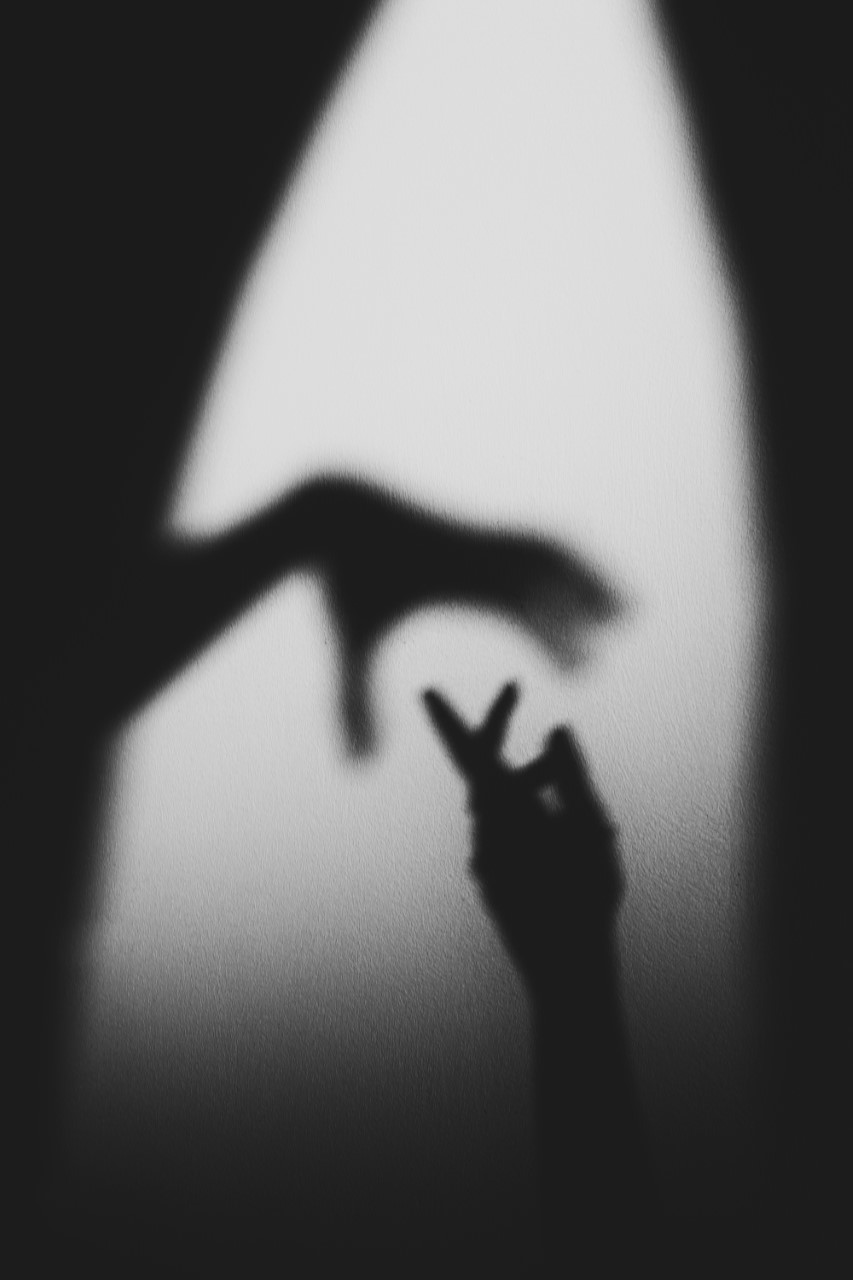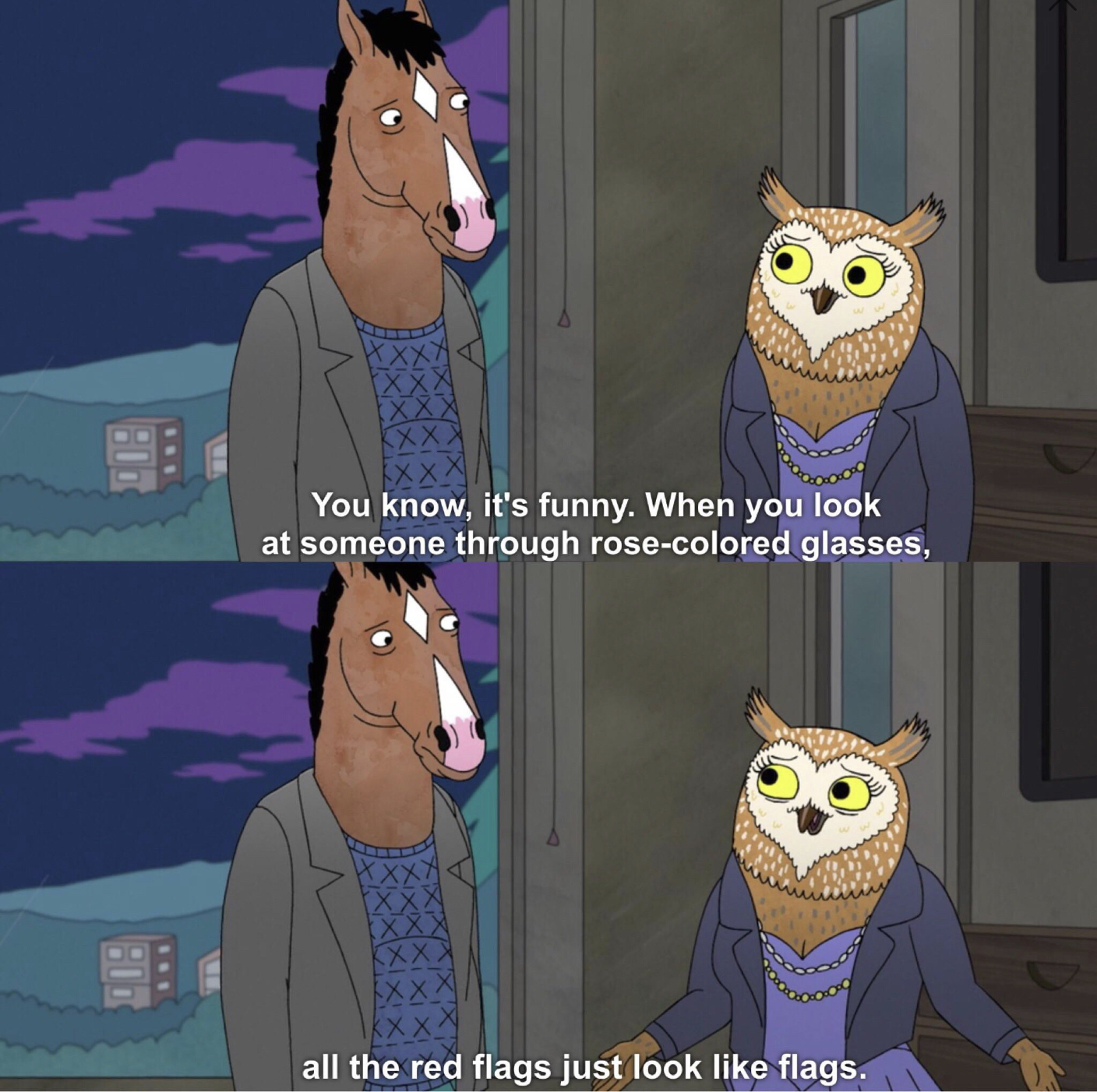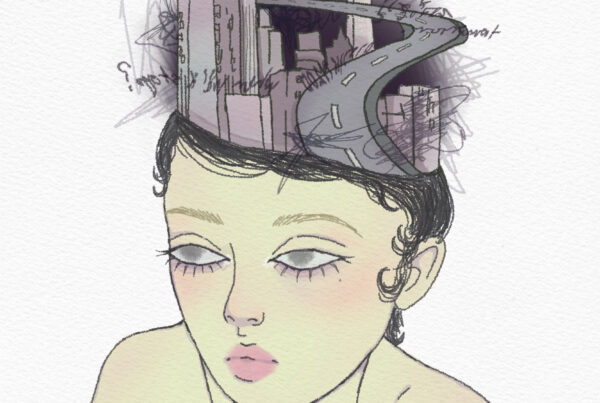
Love shouldn’t hurt. It can be painful to hold on though, and at times, it’s dangerous to let go. How can we handle loving and harm in the same person? On one hand we love, and on the other hand, we hate. A tension arises from a discrepancy between beliefs and reality. It must make sense! Why are they causing me pain? Because they care about me.
Love shouldn’t hurt. It can be painful to hold on though, and at times, it’s dangerous to let go. How can we handle loving and harm in the same person? On one hand we love, and on the other hand, we hate. A tension arises from a discrepancy between beliefs and reality. It must make sense! Why are they causing me pain? Because they care about me.

Photo from Bojack Horseman, Season 2, Episode 10

Photo from Bojack Horseman, Season 2, Episode 10
Try imagining the following, or you may have experienced it yourself. One thing leads to the next, and you’re dating. Falling harder every day, and the infatuation grows. They make you the happiest person alive. Then you wake up one day and find yourself miserable. You’re always annoyed, mad, and on edge. Deep down, you feel invalidated and silenced. You love each other, but it’s become a bottomless pit, even a living hell—the passion now swings between love and hatred. You ask yourself: What happened? How did we get here? How relationships like these, which started out like any other relationship, develop into cycles of abuse.
The anxiety results from a contradiction of believing in a loving relationship yet knowing deep down it isn’t the case. The discrepancy between mental and actual reality can paralyse any action to change the abusive situation, together with the use of subliminal power and control techniques to keep the relationship going. By the end, we will dissect the anatomy of an abusive relationship.
Let’s start from the beginning, how relationships start and how they can become abusive. Relationships mostly begin with a honeymoon phase; the butterflies from the first time create the perfect environment to shower each other with love and affection. Then, as each person gets to know the other and gets comfortable, the relationship enters a period of calm. From the start, we lead with our best foot forward which may not be our authentic selves, and that’s okay. It’s a part of getting to know each other and steadily letting the person in whilst learning to build trust. We usually see the so-called ‘bad side’ of our significant others once we have known them for a while. It is expected that tension builds from daily stress and other points of conflict. However, how the pressure is resolved distinguishes a healthy from a toxic relationship. In an ideal situation, conflict resolution comes from talking things out and communicating and respecting boundaries. It is not okay if the stress results in an abusive incident, whether emotional, physical, or sexual.
“How the pressure is resolved distinguishes a healthy from a toxic relationship.”
To raise awareness, we will discuss the types of abuse, as these can easily be swept under the rug. As there is no immediate threat, abuse is almost invisible. Though someone causes harm to us, whether it be emotional, physical, or sexual, it is abuse. It is commonly characterised by intentionality; abuse is intended at times but not always. So, just because “they didn’t mean it” doesn’t minimise their actions. While it can vary in degree, no amount of abuse should be tolerated. Emotional abuse comprises non-physical behaviours intended to control, isolate, or terrify. Physical abuse is defined as aggressive or violent behaviour resulting in bodily harm. Sexual abuse refers to sexual contact or activity without the survivor’s permission (Staff, 2016). It’s a sensitive topic, but sexual abuse comes from unwanted sexual contact. Consent must be explicitly expressed; it cannot be inferred by silence or default. As the abuse is socially constructed in that recognition of a survivor’s suffering varies due to context, these conversations must define abuse.
For some, it may be hard to wrap their heads around the idea that love and hate can exist in the same space. Love and abuse cannot exist in the same relationship, but somehow it does. According to cognitive dissonance theory, when an individual maintains two or more components of information that are significant to each other yet contradictory, a condition of discomfort known as dissonance emerges (Shah & Gardner, 2008). The uncomfortable dissonance motivates people to engage in psychological activity to eliminate the contradiction between cognitions. In the case of relationships, this could mean leaving, though in most cases, it means staying because you love unconditionally, right? The love is conflicting, yet so overwhelming that it excuses any instances of abuse. Abusive relationships are like roller coaster rides with extreme highs and lows, and severe feelings of love and hate. For instance, Jin et al. (2017) found that stronger sentiments of love related to stronger feelings of hatred after the relationship has ended, which implies a connection between romantic love and hate. Love and hate are opposite sides of the same coin.
However, cognitive dissonance is not the only reason toxic relationships survive. Abuse is so subtle that it goes unnoticed until it is too late. Predators utilise grooming, a manipulative process to create a sense of trust, to create a false safe space before the actual victimisation. The perpetrator might be extremely amorous by love bombing, seeming charming, and wanting alone time (Fontes, 2019). Supposedly harmless acts of love that are meant to set the stage. Along with cognitive dissonance, there is a constant question about the survivor’s reality inside the relationship. Once the abuse incident happens, it slowly becomes normalised. It starts light, with minimising, denying, and blaming, which can lead to the use of coercion and threats and later intimidating and isolating. Together, the normalisation and isolation make it difficult to reach out. The relationship can become addicting due to the overwhelming amount of love. As a result, abusive behaviour might be dismissed as the perpetrator acting out of infatuation. Controlling jealousy, for example, is explained away by love. But ultimately, these tactics create a power and control dynamic that is difficult to escape.
“Abusive relationships are like roller coaster rides with extreme highs and lows, and severe feelings of love and hate.”
On top of the already confusing shift from a loving environment to an abusive relationship, there is a normalisation of victim blaming both as an internal dialogue and within our society. We see that people select their actions and are free to do so and as a result, we hold people responsible for their behaviour and often blame the victim. The belief that peoples get what they deserve, also known as the “just-world bias”, occurs because our brains crave predictability. Consequently, we tend to blame survivors of unfairness rather than rejecting the comforting worldview that suggests that good will be rewarded and evil will be punished. Let us be clear, not everything happens for a reason; it’s a twisted world.
Ultimately, we must create a safe space for those needing help. Take it as your responsibility to see if the interactions with those close to you are free of judgement and dominant in loving concern. Never start a conversation with the perpetrator present. Instead, be aware of the signs, bring up concerns, listen without judgement and above all, believe them. Keep supporting them. You can only do so much, so accept their attitude but offer resources. If anything about this resonated with you, prioritise your safety, but please talk to someone.<<
References
– Fontes, L. A. (2019, February 19). How domestic abusers groom and isolate their victims. Psychology Today. Retrieved February 2023, from https://www.psychologytoday.com/us/blog/invisible-chains/201902/how-domestic-abusers-groom-and-isolate-their-victims
– Jin, W., Xiang, Y., & Lei, M. (2017). The deeper the love, the deeper the hate. Frontiers in Psychology, 8. https://doi.org/10.3389/fpsyg.2017.01940
– Shah, J. Y., & Gardner, W. L. (2008). Cognitive Dissonance Theory. In Handbook of Motivation Science (pp. 71–83). essay, Guilford Press.
– Staff, P. C. (2016, May 17). What are the types of abuse? psychological, physical, and more. Psych Central. Retrieved February 2023, from https://psychcentral.com/lib/types-of-abuse#1
Try imagining the following, or you may have experienced it yourself. One thing leads to the next, and you’re dating. Falling harder every day, and the infatuation grows. They make you the happiest person alive. Then you wake up one day and find yourself miserable. You’re always annoyed, mad, and on edge. Deep down, you feel invalidated and silenced. You love each other, but it’s become a bottomless pit, even a living hell—the passion now swings between love and hatred. You ask yourself: What happened? How did we get here? How relationships like these, which started out like any other relationship, develop into cycles of abuse.
The anxiety results from a contradiction of believing in a loving relationship yet knowing deep down it isn’t the case. The discrepancy between mental and actual reality can paralyse any action to change the abusive situation, together with the use of subliminal power and control techniques to keep the relationship going. By the end, we will dissect the anatomy of an abusive relationship.
Let’s start from the beginning, how relationships start and how they can become abusive. Relationships mostly begin with a honeymoon phase; the butterflies from the first time create the perfect environment to shower each other with love and affection. Then, as each person gets to know the other and gets comfortable, the relationship enters a period of calm. From the start, we lead with our best foot forward which may not be our authentic selves, and that’s okay. It’s a part of getting to know each other and steadily letting the person in whilst learning to build trust. We usually see the so-called ‘bad side’ of our significant others once we have known them for a while. It is expected that tension builds from daily stress and other points of conflict. However, how the pressure is resolved distinguishes a healthy from a toxic relationship. In an ideal situation, conflict resolution comes from talking things out and communicating and respecting boundaries. It is not okay if the stress results in an abusive incident, whether emotional, physical, or sexual.
“How the pressure is resolved distinguishes a healthy from a toxic relationship.”
To raise awareness, we will discuss the types of abuse, as these can easily be swept under the rug. As there is no immediate threat, abuse is almost invisible. Though someone causes harm to us, whether it be emotional, physical, or sexual, it is abuse. It is commonly characterised by intentionality; abuse is intended at times but not always. So, just because “they didn’t mean it” doesn’t minimise their actions. While it can vary in degree, no amount of abuse should be tolerated. Emotional abuse comprises non-physical behaviours intended to control, isolate, or terrify. Physical abuse is defined as aggressive or violent behaviour resulting in bodily harm. Sexual abuse refers to sexual contact or activity without the survivor’s permission (Staff, 2016). It’s a sensitive topic, but sexual abuse comes from unwanted sexual contact. Consent must be explicitly expressed; it cannot be inferred by silence or default. As the abuse is socially constructed in that recognition of a survivor’s suffering varies due to context, these conversations must define abuse.
For some, it may be hard to wrap their heads around the idea that love and hate can exist in the same space. Love and abuse cannot exist in the same relationship, but somehow it does. According to cognitive dissonance theory, when an individual maintains two or more components of information that are significant to each other yet contradictory, a condition of discomfort known as dissonance emerges (Shah & Gardner, 2008). The uncomfortable dissonance motivates people to engage in psychological activity to eliminate the contradiction between cognitions. In the case of relationships, this could mean leaving, though in most cases, it means staying because you love unconditionally, right? The love is conflicting, yet so overwhelming that it excuses any instances of abuse. Abusive relationships are like roller coaster rides with extreme highs and lows, and severe feelings of love and hate. For instance, Jin et al. (2017) found that stronger sentiments of love related to stronger feelings of hatred after the relationship has ended, which implies a connection between romantic love and hate. Love and hate are opposite sides of the same coin.
However, cognitive dissonance is not the only reason toxic relationships survive. Abuse is so subtle that it goes unnoticed until it is too late. Predators utilise grooming, a manipulative process to create a sense of trust, to create a false safe space before the actual victimisation. The perpetrator might be extremely amorous by love bombing, seeming charming, and wanting alone time (Fontes, 2019). Supposedly harmless acts of love that are meant to set the stage. Along with cognitive dissonance, there is a constant question about the survivor’s reality inside the relationship. Once the abuse incident happens, it slowly becomes normalised. It starts light, with minimising, denying, and blaming, which can lead to the use of coercion and threats and later intimidating and isolating. Together, the normalisation and isolation make it difficult to reach out. The relationship can become addicting due to the overwhelming amount of love. As a result, abusive behaviour might be dismissed as the perpetrator acting out of infatuation. Controlling jealousy, for example, is explained away by love. But ultimately, these tactics create a power and control dynamic that is difficult to escape.
“Abusive relationships are like roller coaster rides with extreme highs and lows, and severe feelings of love and hate.”
On top of the already confusing shift from a loving environment to an abusive relationship, there is a normalisation of victim blaming both as an internal dialogue and within our society. We see that people select their actions and are free to do so and as a result, we hold people responsible for their behaviour and often blame the victim. The belief that peoples get what they deserve, also known as the “just-world bias”, occurs because our brains crave predictability. Consequently, we tend to blame survivors of unfairness rather than rejecting the comforting worldview that suggests that good will be rewarded and evil will be punished. Let us be clear, not everything happens for a reason; it’s a twisted world.
Ultimately, we must create a safe space for those needing help. Take it as your responsibility to see if the interactions with those close to you are free of judgement and dominant in loving concern. Never start a conversation with the perpetrator present. Instead, be aware of the signs, bring up concerns, listen without judgement and above all, believe them. Keep supporting them. You can only do so much, so accept their attitude but offer resources. If anything about this resonated with you, prioritise your safety, but please talk to someone.<<



